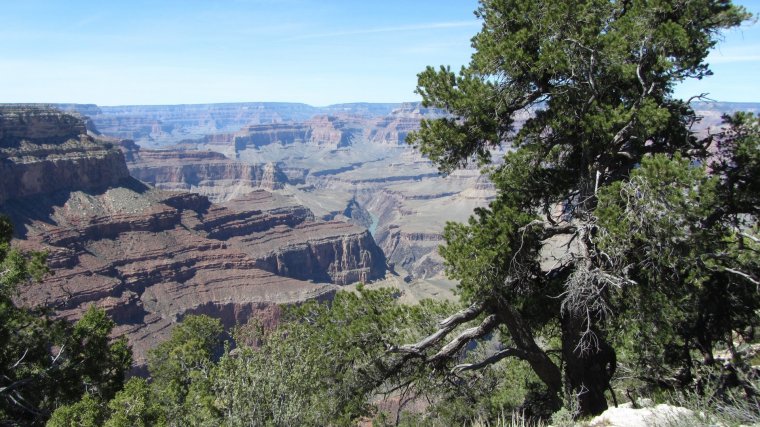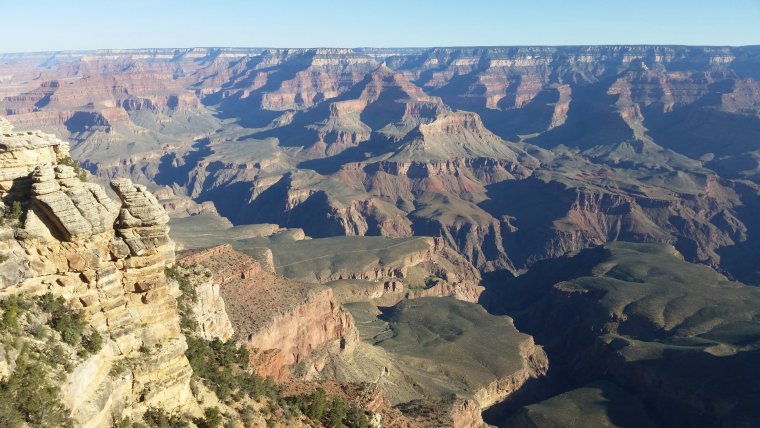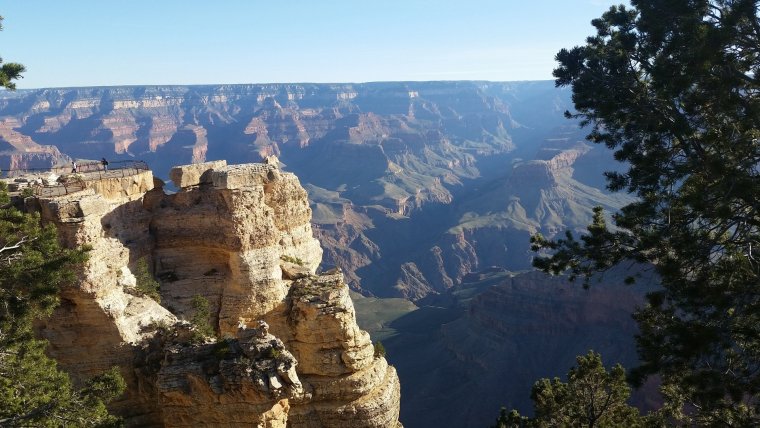| Published in Attractions / Places of Interest |
Grand Canyon National Park

Canoeing on Colorado River
Grand Canyon was and is still carved by the Colorado River in Arizona, United States. The Grand Canyon is 446 km long, up to 29 km wide and attains a depth of 1,857 meters.
The Ancestral Puebloans were the first people known to live in the Grand Canyon area. In addition to the Ancestral Puebloans, a number of distinct cultures have inhabited the area. The Cohonina lived to the west of the Grand Canyon, between 500 and 1200 CE. The Cohonina were ancestors of the Yuman, Havasupai, and Hualapai peoples who inhabit the area today.
The Sinagua were a cultural group occupying an area to the southeast of the Grand Canyon, between the Little Colorado River and the Salt River, between approximately 500 and 1425 CE. The Sinagua may have been ancestors of several Hopi clans.
By the time of the arrival of Europeans in the 16th century, newer cultures had evolved. The Hualapai inhabit a 100-mile (160 km) stretch along the pine-clad southern side of the Grand Canyon. The Havasupai have been living in the area near Cataract Canyon since the beginning of the 13th century, occupying an area the size of Delaware.
The Southern Paiutes live in what is now southern Utah and northern Arizona. The Navajo, or Diné, live in a wide area stretching from the San Francisco Peaks eastwards towards the Four Corners. Archaeological and linguistic evidence suggests the Navajo descended from the Athabaskan people near Great Slave Lake, Canada, who migrated after the 11th century.
In September 1540 Captain García López de Cárdenas, a Spanish conquistador and first European to see the Grand Canyon, along with Hopi guides and a small group of Spanish soldiers, traveled to the south rim of the Grand Canyon between Desert View and Moran Point. Pablo de Melgrossa, Juan Galeras, and a third soldier descended some one third of the way into the canyon until they were forced to return because of lack of water.
In their report, they noted that some of the rocks in the canyon were "bigger than the great tower of Seville, Giralda." It is speculated that their Hopi guides likely knew routes to the canyon floor, but may have been reluctant to lead the Spanish to the river. No Europeans visited the canyon again for more than two hundred years.
Today, the most visited part is the South Rim, which is managed by the National Park Service and is open all year. South Rim rises 2134 m above sea level and has several dozen memorable viewpoints. About 5.5 million tourists visit every year, and it’s about five or six hours away from Las Vegas by car.
There are several hotels and lodges in Grand Canyon Village on the South Rim. Due to high demand, is advisable to make reservation as early as possible. Costs range between about $130 and $450 per night. Free shuttle buses connect the lodges with restaurants, shops, visitor centers, scenic overlooks and trail heads.
The North Rim is closed in winter and opens around mid May. Averaging 2438 m above sea level, and because of its remote location, is less accessible than the South Rim. Although during winter months all North Rim roads are closed, hikers may enter the North Rim with valid permits.
The Grand Canyon West region is owned and operated by the Hualapai Indians. With two million visitors a year, Grand Canyon West is quieter than the South Rim. It has fewer accommodation options than South Rim, but it offers unique attractions, such as the Grand Canyon Skywalk. It is also only about two hour drive from Las Vegas.
What to do around Grand Canyon
• Learn about Grand Canyon nature, science, history and culture with a park ranger as your guide.
• Stop by the Visitor Center, an Historic Home or Museum. The South Rim offers a variety of museums and information centers that house exhibits and provide park information.
• Walk part of the well defined, and mostly level Rim Trail, starting from any viewpoint in the village or along the historic Hermit Road and greenway. Day hike in and around the canyon or backpack overnight below the rim. (a backcountry permit is required).
• Tour Scenic Hermit Road (also known as West Rim Drive). Free shuttle bus service runs March 1 through Nov. 30, During this time, the road is closed to private vehicles. In addition to the main road, there is a designated greenway for travel by foot or bicycle. Commercial bus tours, jeep tours, and van tours, are also available.
• Tour Desert View Drive (Hwy 64 - also known as East Rim Drive). This 42 km road, leaves Grand Canyon Village, then travels east to Desert View. You can drive your private vehicle, or take a commercial bus tour, jeep tour, or van tour.
• At Desert View Point (South Rim) climb to the top of a 21.5 m tall stone Watchtower for a panoramic view extending more than 160 km on a clear day. The historic Watchtower is a replica of prehistoric towers found on the Colorado Plateau, and was designed in 1932 by Mary Colter.
• Tusayan Ruin is the remains of a small Ancestral Puebloan village located 5 km west of Desert View. Tusayan Museum has exhibits that help bring the pueblo to life. Admission is free. Hours: 9 am to 5 pm. There are also ranger-led tours of the ruins daily.
• South Rim Mule Trips are offered year round. The Canyon Vistas Ride is a 3 hour trip that travels along the canyon rim. Overnight Rides go to the bottom of the canyon and stay at Phantom Ranch.
• The Grand Canyon Conservancy Field Institute offers guided educational tours led by expert instructors while backpacking, camping, hiking, and whitewater rafting. Topics include geology, history, archaeology, photography, and more.
• Whitewater and Smoothwater raft trips on the Colorado River. Whitewater trips through Grand Canyon last from 3 days to 21 days and require reservations made well in advance, or a noncommercial permit obtained by entering a lottery.
• Journey to Grand Canyon National Park aboard Grand Canyon Railway. From Williams, Arizona (along Interstate 40) the Grand Canyon Railway carries more than 230,000 people by rail to Grand Canyon National Park each year.
Grand Canyon National Park in Pictures

Colorado River in the distance.

Grand Canyon South Rim

Mather Point at Grand Canyon South Rim

Down on a trail in Grand Canyon South Rim

Horseshoe Bend is 8 km from the beginning of Grand Canyon National Park, close to Page, Arizona.

Colorado River before entering Horseshoe Bend
DANIEL ŞTEFĂNIŢĂ
YOU MAY ALSO LIKE





 If you own or manage a travel-related business such as a hotel, a bed-and-breakfast, a restaurant, a pub or a cafeteria, you can create a web page for your business for free on Titi Tudorancea Travel Info. » |
